Mitac Digital Technology AVIC-F500BT ADVANCED MULTIMEDIA NAVIGATION SYSTEM User Manual NN749 English HW manual for Safety rev
Mitac International Corporation ADVANCED MULTIMEDIA NAVIGATION SYSTEM NN749 English HW manual for Safety rev
Manual

AVIC-F500BT
ADVANCED MULTIMEDIA
NAVIGATION SYSTEM
Hardware User Manual
R00
Trademarks
The Bluetooth word mark and logo are owned by the Bluetooth SIG, Inc. All
other brand and product names are trademarks or registered trademarks of their
respective companies.
Note
The information in this document is subject to change without notice.

i
Table of Contents
Notice .................................................................................................. ii
1 Getting Started ............................................................................. 3
1.1
Understanding Hardware Features ................................................... 3
Front Components............................................................................. 3
Back Components ............................................................................. 4
Right-Side Components .................................................................... 5
Left-Side Components....................................................................... 5
1.2
Installing the Battery .......................................................................... 6
1.3
Connecting to AC Power and Charging the Battery.......................... 7
1.4
Using Your Device in a Vehicle ......................................................... 8
Connections....................................................................................... 8
Using the Device Cradle.................................................................... 9
Connecting the Car Charger............................................................ 10
1.5
Turning Your Device On and Off ..................................................... 11
1.6
Navigating on the Screen ................................................................ 11
1.7
Using a SD Card.............................................................................. 12
2 Troubleshooting and Maintenance ........................................... 13
2.1
Resetting Your System.................................................................... 13
Hard Reset....................................................................................... 14
2.2
Troubleshooting............................................................................... 15
Power Problems .............................................................................. 15
Screen Problems ............................................................................. 15
GPS Problems................................................................................. 15
2.3
Maintaining Your Device.................................................................. 17

ii
Notice
Before using this product, read “Important Information for the User” (a
separate manual) which contains warnings, cautions, and other important
information that you have to follow.
This manual provides only the hardware information. For information on
the GPS navigation software and other software operations, see the
“Software Operation Manual.”
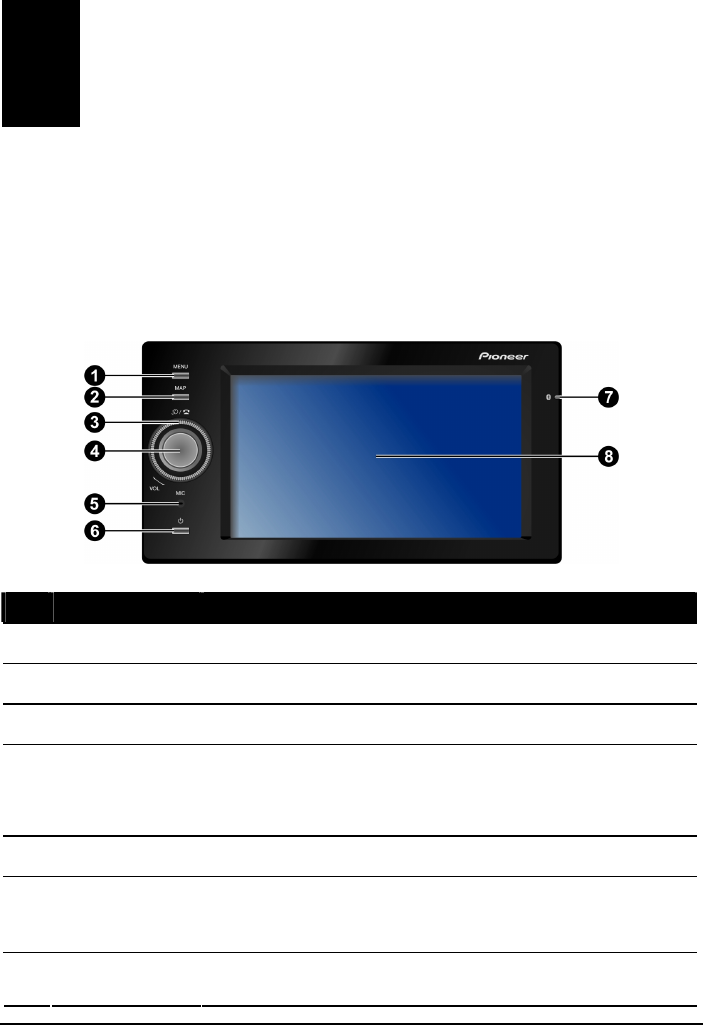
3
1 Getting Started
1.1 Understanding Hardware Features
Front Components
Ref
Component Description
Menu Button Press to open the Main Menu.
Map Button Press to open the Map Menu.
Scroll Wheel Rotate to adjust the volume.
Control Button
Map zoom in and zoom out by pressing up and down.
Audio track up and down by pressing left and right.
Activate the Bluetooth function by pressing the center.
Microphone For Bluetooth hands-free calling.
Power Button Turns the device on and off by pressing for at least 2
seconds. (See sections 1.5 for more information on the
Power Button functions).
Bluetooth
Indicator Flashes (Blue) to indicate that the Bluetooth is in searching
and pairing mode.
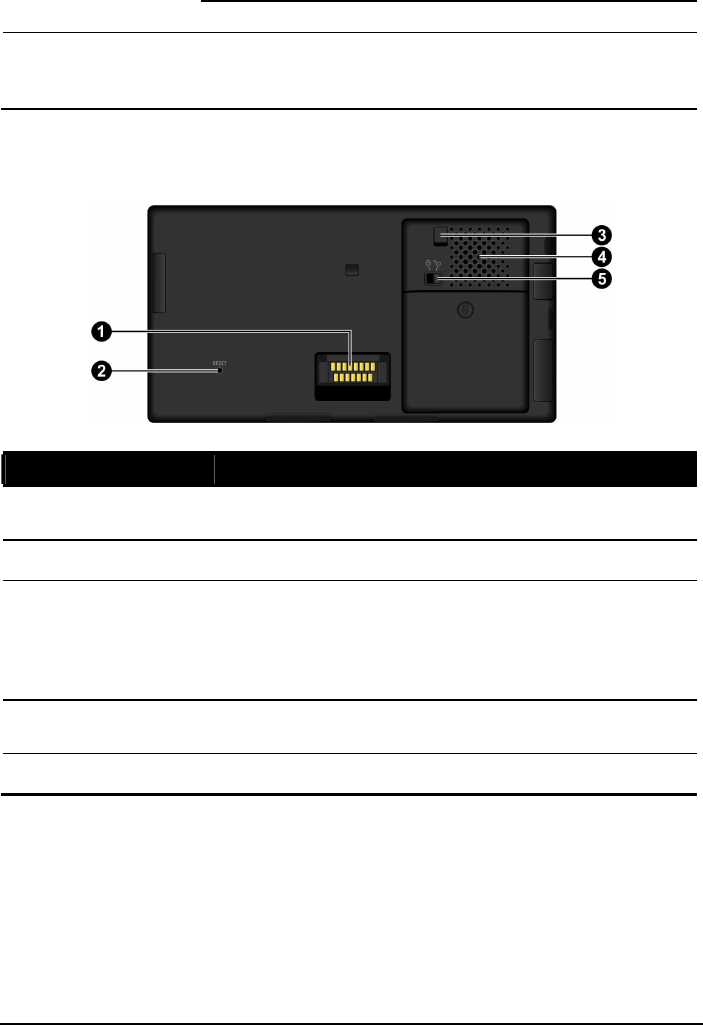
4
Glows in blue when connected to a Bluetooth device.
Touch Screen Displays the output of your device. Touch the screen with
your fingertip to select menu commands or enter
information.
Back Components
Ref
Component Description
Cradle
Connector Connects to the cradle. (The cradle supplied with your
device depends on the country/region you are in.)
Reset Button Restarts your device (soft reset).
External GPS
Antenna
connector
This connector (under rubber dust cover) allows the use of
an external GPS antenna which may be positioned on top of
the vehicle for better signal reception in areas with poor
reception. (Contact Pioneer Support Center for
recommendations on available third party products.)
Speaker For voice prompts, system operation tones, and hands free
telephone calls.
Battery Lock Lock or unlock the battery cover.
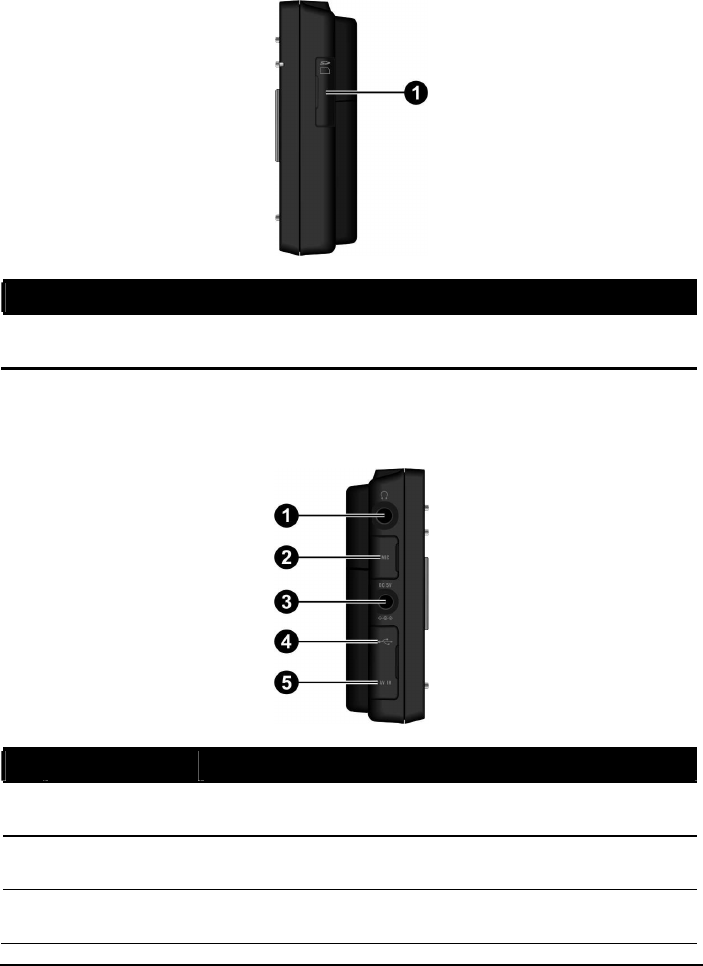
5
Right-Side Components
Ref
Component Description
SD slot Accepts an SD (Secure Digital) card for data and future
software updates.
Left-Side Components
Ref
Component Description
Headphone
Connector Connects to stereo headphones.
Microphone
Connector Connects to an external microphone (under rubber dust
cover).
Power
Connector Connects to the AC adapter.
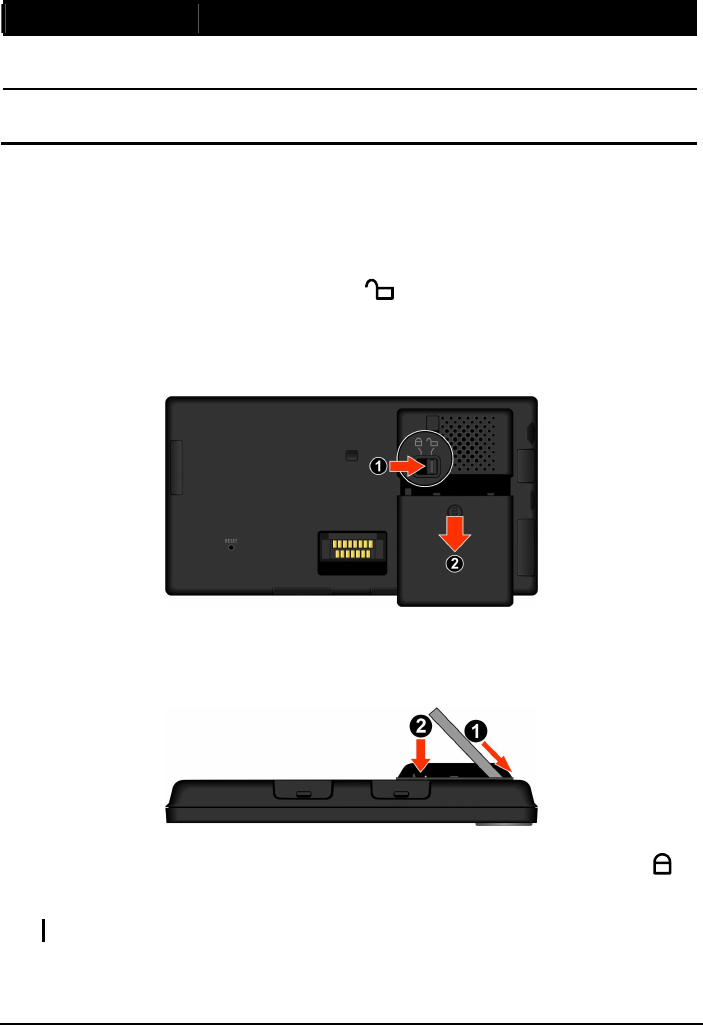
6
Ref
Component Description
Mini-USB
Connector Connects to the mini-USB cable for iPod or the convertible
cable for USB device (under rubber dust cover).
AV IN
Connector Connects to AV jack for iPod or an external video source
(under rubber dust cover).
1.2 Installing the Battery
1. Make sure that the device is not turned on or connected to the AC power.
2. Slide the battery lock to the unlock ( ) position ().
3. Slide the battery cover downward and remove the cover from the battery
compartment ().
4. Insert the battery pack (provided with your device) into the right side of the
compartment first, and then press down until you hear it “Click”.
5. Replace the battery cover and slide the battery lock back to the lock ( )
position.
NOTE: To remove the battery, see section 2.1 for more information.
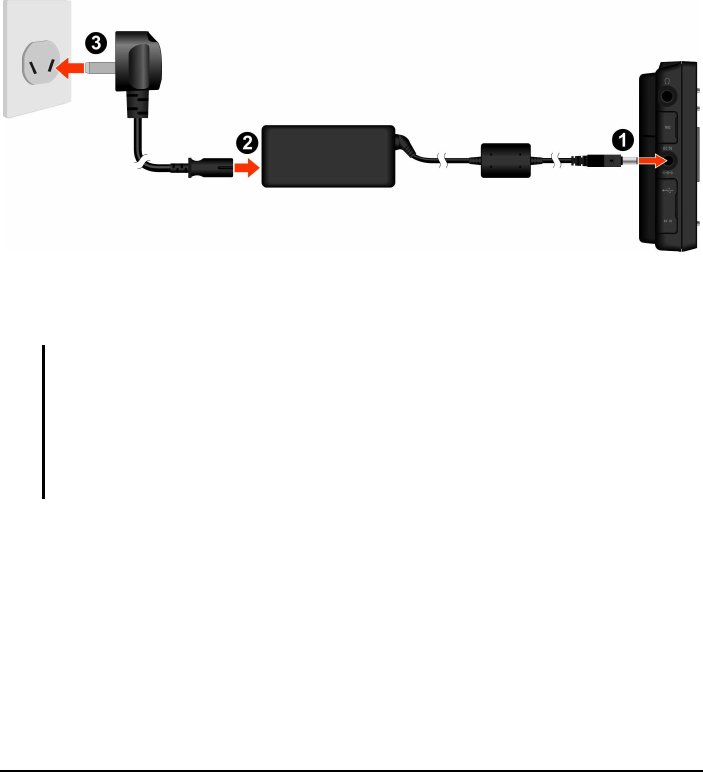
7
1.3 Connecting to AC Power and Charging the
Battery
Please fully charge your device before using it the first time.
1. Connect the AC adapter to the power connector on your device ().
2. Connect one end of the power cable to the AC adapter () and the other end
to a wall outlet ().
Do not disconnect your device from AC power until the battery is fully charged.
It may take several hours to fully charge.
CAUTION: For optimal performance of the lithium battery, take note of the following:
Do not charge the battery where the temperature is high (e.g. in direct sunlight).
Unlike other rechargeable batteries, there is no need to fully discharge the lithium
battery before recharging.
If you will not use the product for a long period of time, be sure to fully recharge the
battery at least once every two weeks. Over discharge of the lithium battery can affect
the charging performance.
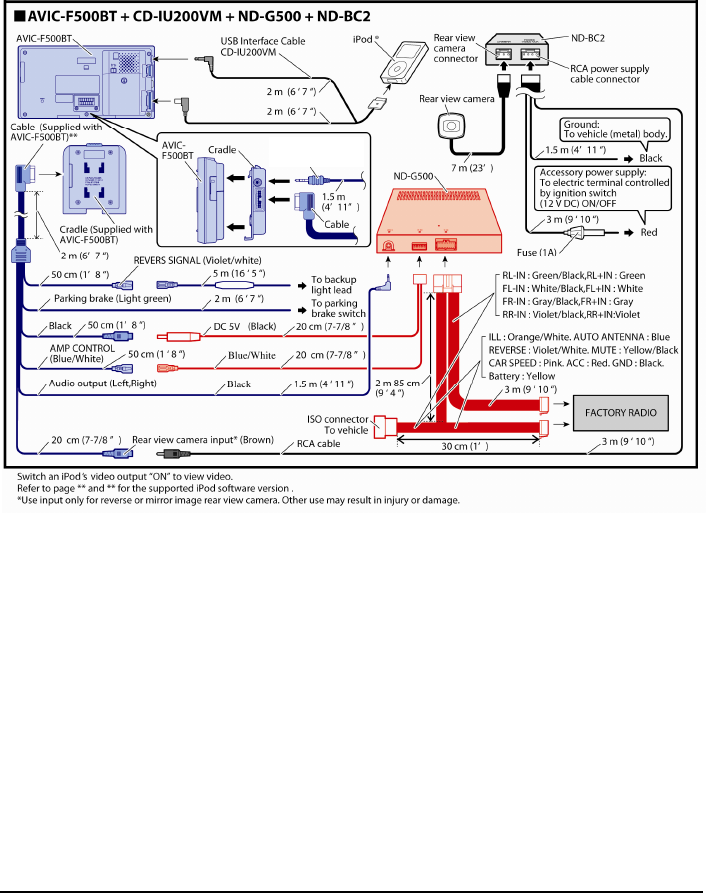
8
1.4 Using Your Device in a Vehicle
Connections
TMC Antenna
(optional)
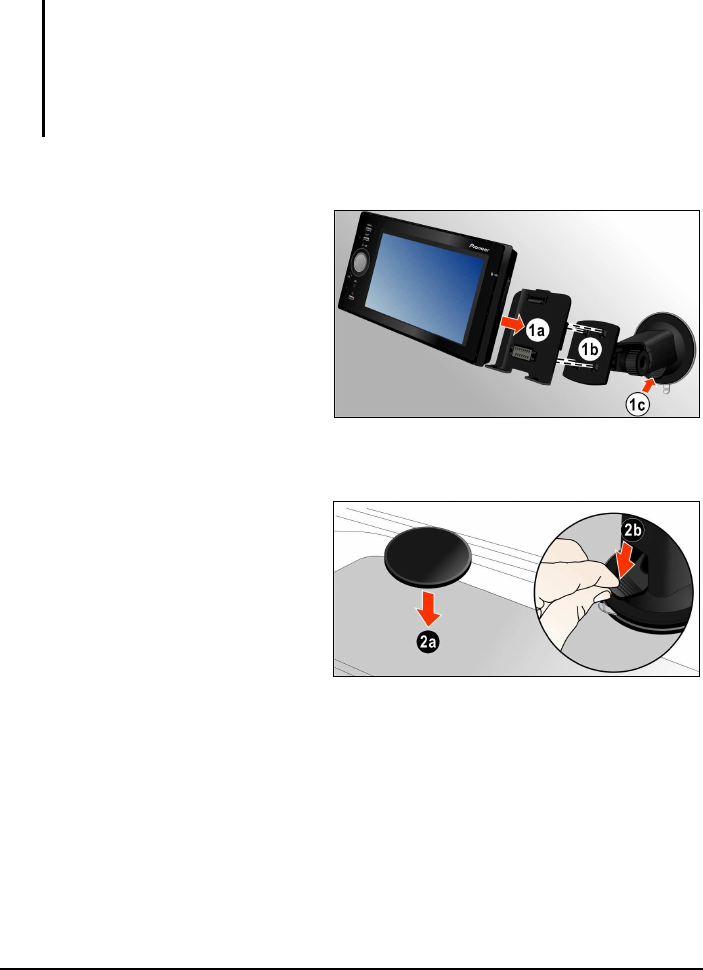
9
Using the Device Cradle
NOTE:
Depending upon the specific model available in your country/region, the device cradle
supplied with your device may not look exactly the same as the picture shown.
If the windshield of your vehicle is tinted with a reflective coating, an external antenna
(optional) may be needed to route the antenna to the top of the car through a window.
Don’t leave the device in the place where it gets direct rays of the sun.
Mounting on the Windshield
Attach the device to the device
cradle (1a). Then slide the cradle
into the adapter end of the suction
mount (1b) and lock into place by
pressing down. Lastly, attach the
suction side of the suction mount
to your windshield, and lock by
pressing the lever toward the
suction cup (1c).
Mounting on the Dashboard
Attach the device to the device
cradle and the adapter end of the
suction mount as described above
(1a and 1b). Stick the Dash
Mounting Plate onto your
dashboard (2a), and attach the
suction side of the suction mount
to the plate (2b).
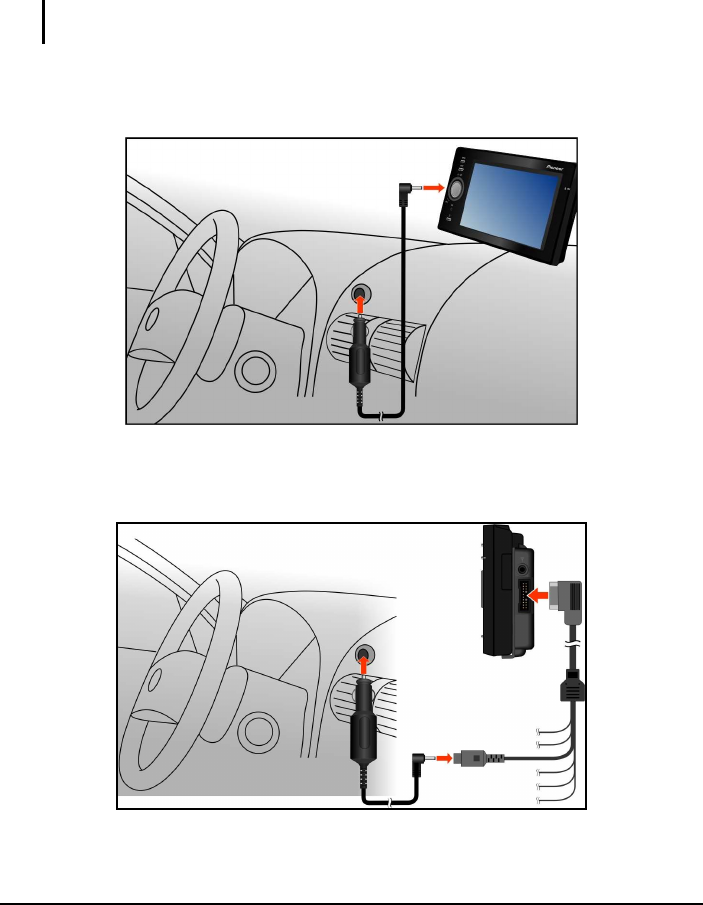
10
Connecting the Car Charger
The car charger supplies power to your device when you are using the device in
a vehicle.
CAUTION: To protect your device against sudden surges in current, connect the car
charger only after the vehicle engine has started.
1. Connect one end of the car charger directly to the power connector on your
device.
If you are using the ND-G500 (supplied with AVIC-F500BT), you need to
connect to the black cradle cable. (See the “Connections” section for details.)
2. Connect the other end to the 12-volt cigarette lighter or power port to power
and charge your device.
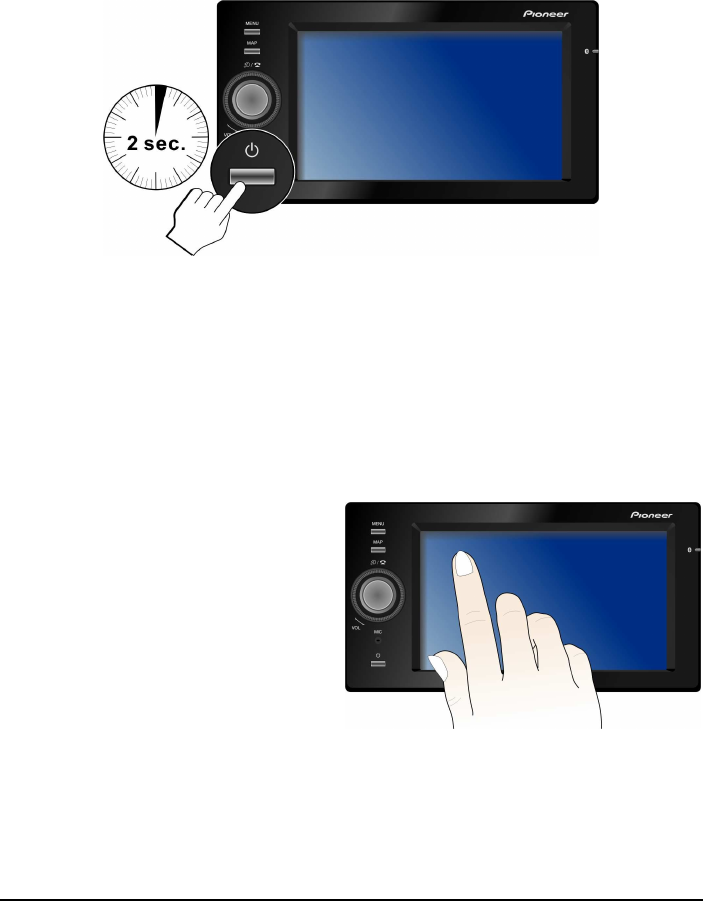
11
1.5 Turning Your Device On and Off
Press and hold the power button for at least 2 seconds to turn on and off your
device.
When you press the power button to turn off the unit, your device actually enters
into a suspend state and the system stops operating. Once you turn on the system
again, it resumes from the same screen you left off at.
1.6 Navigating on the Screen
To navigate and select objects on the screen, simply use your finger and touch
the screen. The followings are possible via touch screen:
Tap
Touch the screen once with
your finger to open items or
select options.
Drag
Hold your finger on the screen
and drag up/down/left/right or
across the screen.
Tap and hold
Tap and hold your finger until an action is complete, or a result or menu is
shown.
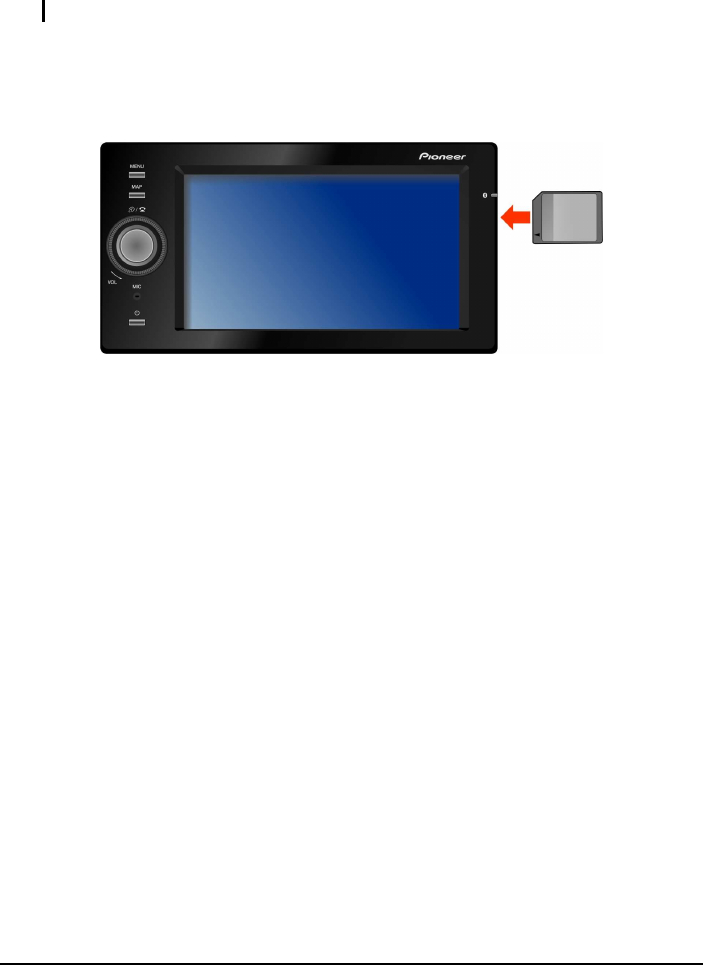
12
1.7 Using a SD Card
NOTE: Please ensure that no foreign objects enter the card slot.
Your device features a SD slot where you can insert an optional storage card. To
use a storage card, insert it into the card slot, with the connector pointing to the
slot and its label facing the front of the device.
To remove a card, first make sure that no application is accessing the card, and
then slightly push the top edge of the card to release it and then pull it out of the
slot.
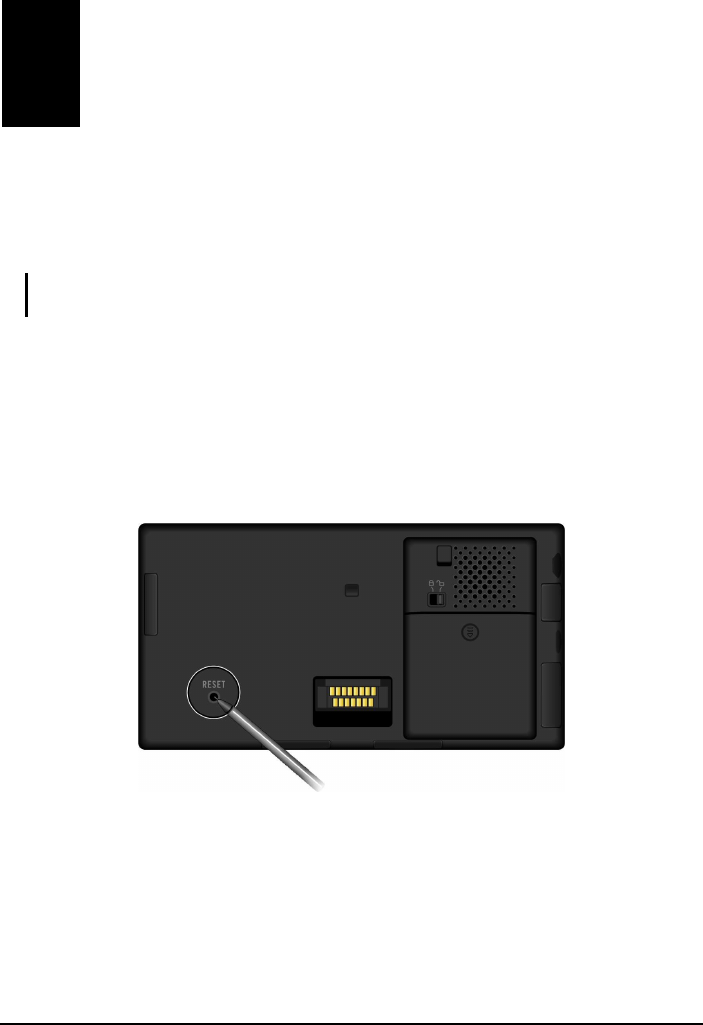
13
2
Troubleshooting and Maintenance
This chapter gives you solutions to some problems you may encounter. It also
provides guidelines on how to care for your device.
NOTE: If you encounter a problem you cannot solve, contact Pioneer Customer Service for
assistance.
2.1 Resetting Your System
Occasionally, you may need to reset your device.
Use a pointed object (avoiding sharp objects) to press the reset button on your
device. This is called a “soft reset.”
Troubleshooting and
Maintenance
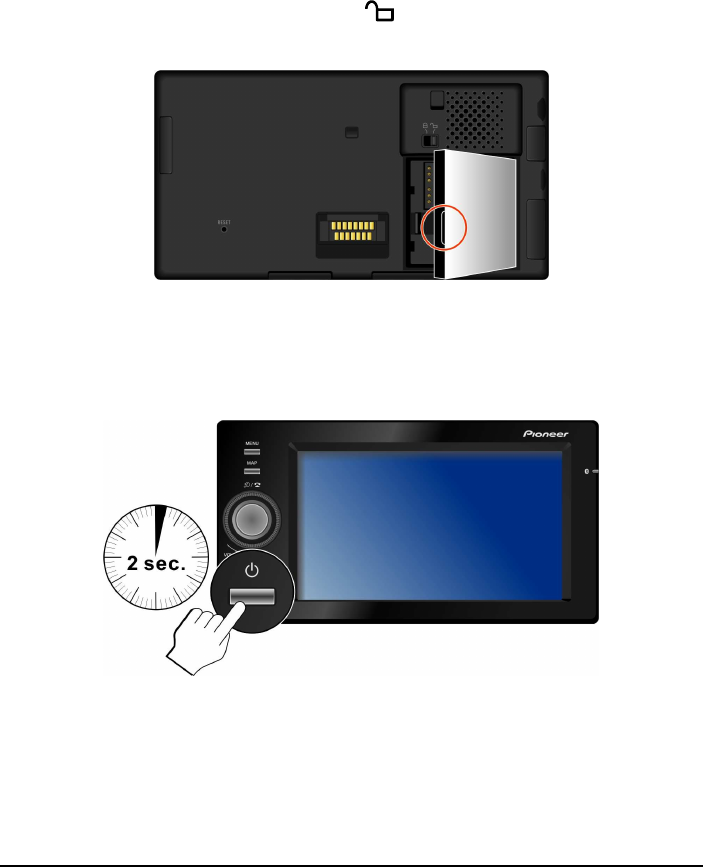
14
Hard Reset
If your device still does not respond after a soft reset, you can use the following
steps to perform a “hard reset.”
1. Disconnect all the cables, including the AC adapter, from your device.
2. Slide the battery lock to the unlock ( ) position and remove the battery
cover. Lift the battery upward to release it from its compartment.
3. Wait for a few seconds. Reconnect the AC power and replace the battery
back to its compartment. (See section 1.2 on installing the battery.)
4. Press the power button for at least 2 seconds to turn on your device.

15
2.2 Troubleshooting
Power Problems
Power does not turn on when using battery power
The remaining battery power may be too low to run your device. Connect
the AC adapter to your device and then to AC power. Then, turn on your
device.
Screen Problems
Screen is off
If the screen does not respond even after you press the power button, try the
following steps in this order until the problem is solved:
Connect the AC adapter to your device and to external AC power.
Reset your system. (See Section 2.1 for information.)
Screen responds slowly
Make sure that your device is not running out of battery power. If the
problem still exists, reset your system.
Screen freezes
Reset your system. (See Section 2.1 for information.)
Screen is hard to read
Make sure that the backlight of the display is on and if necessary adjust the
brightness.
GPS Problems
When there are no valid GPS signals available, consider the following:
Make sure that the device has an unobstructed view of the sky.
Note that the GPS reception can be affected by:

16
Bad weather
Dense overhead obstacles (e.g. trees and tall buildings)
Other wireless device in the vehicle
Reflective window tint and heated screens

17
2.3 Maintaining Your Device
Taking good care of your device will ensure trouble-free operation and reduce
the risk of damage to your device.
Keep your device away from excessive moisture and extreme temperatures.
Avoid exposing your device to direct sunlight or strong ultraviolet light for
extended periods of time.
Do not place anything on top of your device or drop objects on your device.
Do not drop your device or subject it to severe shock.
Do not subject your device to sudden and severe temperature changes. This
could cause moisture and condensation build up inside the unit which can
damage your device. In the event of moisture or condensation, allow the
device to dry out completely before use.
Avoid touching the Screen Surface with sharp objects as it may scratch.
Non-adhesive generic screen protectors designed specifically for use on
portable devices with LCD panels may be used to help protect the screen
from minor scratches.
Never clean your device with it powered on. Use a soft, lint-free cloth
moistened with water to wipe the screen and the exterior of your device.
Do not use paper towels to clean the screen as this may scratch it.
Never attempt to disassemble, repair or make any modifications to your
device. Disassembly, modification or any attempt at repair could cause
damage to your device and even bodily injury or property damage and will
void any warranty.
Do not store or carry flammable liquids, gases or explosive
materials in the same compartment as your device, its parts or accessories.

18
Federal Communication Commission Interference Statement
This equipment has been tested and found to comply with the limits for a
Class B digital device, pursuant to Part 15 of the FCC Rules. These limits are
designed to provide reasonable protection against harmful interference in a
residential installation. This equipment generates, uses and can radiate radio
frequency energy and, if not installed and used in accordance with the
instructions, may cause harmful interference to radio communications.
However, there is no guarantee that interference will not occur in a particular
installation. If this equipment does cause harmful interference to radio or
television reception, which can be determined by turning the equipment off and
on, the user is encouraged to try to correct the interference by one of the
following measures:
- Reorient or relocate the receiving antenna.
- Increase the separation between the equipment and receiver.
- Connect the equipment into an outlet on a circuit different from that
to which the receiver is connected.
- Consult the dealer or an experienced radio/TV technician for help.
FCC Caution: Any changes or modifications not expressly approved by the
party responsible for compliance could void the user's authority to operate this
equipment.
This device complies with Part 15 of the FCC Rules. Operation is subject
to the following two conditions: (1) This device may not cause harmful
interference, and (2) this device must accept any interference received,
including interference that may cause undesired operation.
IMPORTANT NOTE:
FCC Radiation Exposure Statement:
This equipment complies with FCC radiation exposure limits set forth for
an uncontrolled environment. This equipment should be installed and operated
with minimum distance 20cm between the radiator & your body.
This transmitter must not be co-located or operating in conjunction with
any other antenna or transmitter.

19
Industry Canada statement:
This device complies with RSS-210 of the Industry Canada Rules. Operation is
subject to the following two conditions:
(1) This device may not cause harmful interference, and (2) this device must
accept any interference received, including interference that may cause
undesired operation.
IMPORTANT NOTE:
Radiation Exposure Statement:
This equipment complies with IC radiation exposure limits set forth for an
uncontrolled environment. This equipment should be installed and operated
with minimum distance 20cm between the radiator & your body.